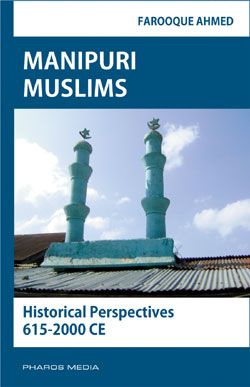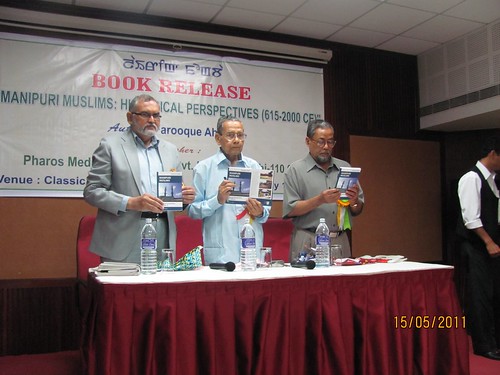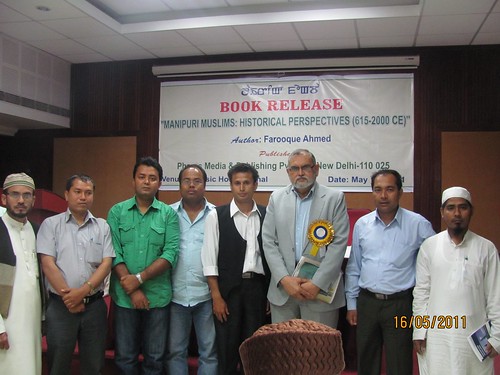By Dr. Syed Ahmed,
A book released recently in Manipur, titled “Manipuri Muslims: Historical Perspectives 615-2000 CE,” authored by Farooque Ahmed, claims that Islam arrived in the region in 615 CE through Saad ibn abi Waqqas and Amir Hamza, uncles of Prophet Muhammad. According to Farooque Ahmed, Aribam, a Muslim clan (sagei) in Manipur, traces its biological ancestry to Amir Hamza and Saad ibn abi Waqqas. He writes: “It is an accepted fact that the Aribam section of Manipuri Muslims traces its biological ancestry to Hamza (567-625 CE), the paternal uncle of prophet and Saad ibn abi Waqqas (d. 647 CE), the maternal uncle of the prophet.” He also writes about a theory that the term “Aribam” is believed to have been derived from the Arabic word “Aribah” meaning “pure Arabs.”
Perspectives 615-2000 CE,” authored by Farooque Ahmed, claims that Islam arrived in the region in 615 CE through Saad ibn abi Waqqas and Amir Hamza, uncles of Prophet Muhammad. According to Farooque Ahmed, Aribam, a Muslim clan (sagei) in Manipur, traces its biological ancestry to Amir Hamza and Saad ibn abi Waqqas. He writes: “It is an accepted fact that the Aribam section of Manipuri Muslims traces its biological ancestry to Hamza (567-625 CE), the paternal uncle of prophet and Saad ibn abi Waqqas (d. 647 CE), the maternal uncle of the prophet.” He also writes about a theory that the term “Aribam” is believed to have been derived from the Arabic word “Aribah” meaning “pure Arabs.”
Farooque Ahmed also writes that Hamza reached Manipur before 610 CE and “Waqqas was among the three sahaba who reportedly left Abyssinia by sea on way to China in 615 CE and reached Manipur via Chittagong port in that year itself.” He also writes that Muhammad Hanifa, the eldest of the two sons born to Caliph Ali and his second wife Khawla bint Jafar, fled to Arakan in 680 CE after he lost the struggle for Caliphate and founded an Islamic community. Muhammad Hanifa paid a visit to Manipur and met the local Muslims, he further claims.
Farooque Ahmed also writes that the Muslim saint (Pangal Musalman Guru) who preached in Manipur during King Nawphangba’s reign in the first decade of the 7th century, as mentioned in the local ,em>puyas (archaic texts), could have been either Saad ibn abi Waqqas or Hamza. He writes: “Evidences indicate that this “guru” was a saintly man. Yet if the Manipuri king reined till 624 CE, this saint could have been either Saad ibn abi Waqqas or Hamza, both of whom were uncles of the Holy Prophet Muhammad. Amir Hamza whom the Prophet addressed as ‘the Lion,’ later went back to Arabia where he was ultimately martyred in the Battle of Uhud in 625 CE during the lifetime of the Prophet. If the mentioned saint could be Saad ibn abi Waqqas, he could have arrived in Manipur by the sea (Bay of Bengal) around 615 CE and then left for home and returned for a second time after 27 years and landed on the Chinese coast bringing with him a copy of the Holy Quran. According to Hui records, Saad ibn abi Waqqas was the progenitor of the Hui (Chinese Muslims) who claim that his tomb is still preserved there. Actually, Saad ibn abi Waqqas died in 674 CE at the age of eighty and was buried there. The mentioned Canton tomb is believed to be that of the son of Waqqas who arrived in the area and probably married a local wife.”
Farooque Ahmed notes that Muslims went to China via Silk route through Manipur. Muslims from Arabia, Persia and Turkey went to China passing through Assam and Manipur that reached Yunan and elsewhere, he further writes.
The book mentions that Muslim population in Manipur suddenly increased in the early part of 17th century with the settlement of large number of Muslim troops, brought from Taraf (in Sylhet) by a Manipuri Prince. The event is detailed thus: “Over the petty issue of a broken boat, Prince Sanongba had a grudge against King Khagemba, fled to Cachar and with a Cachari (Hindu) force invaded Manipur in which Sanongba was defeated in 1604 CE. Even then Sanongba was not deterred, went back again and could contact some (Pangal) Muslim troops from Taraf (in Sylhet). Now it became a combined Muslim-Cachari-Sanongba force led by one Senapati Parshyam. The troops invaded Manipur in 1606 CE…..the Meities captured Pangals and Mayangs numbering up to 1,000 persons…then the Mayangs and Pangals were later settled in Manipur by the king by giving them wives and lands.”

Dr. Zafarul-Islam Khan, Halim Chowdhury and Md. Riyajuddin releasing the book
Farooque Ahmed also claims that Shah Shuja, the son of Shah Jahan, who was chased by his brother Aurangzeb, entered Manipur. He writes: “Because of the hostile attitude of the Burmese king, Shah Shuja who earlier took a flight to Arakan came back to Tripura, the news of which trickled to Aurangzeb who then pressurized the Tripura king to hand over Shuja. Shuja immediately got a hint of it and further fled to Manipur….his date of entrance into Manipur is not exactly recorded…” He further mentions that those Mughals who came along with Shuja were known as Mangal or Mangkons, and their descendants are known as Makakmayum clan. They had a separate office, called Mangol Sanglen, in the royal palace, he added.

Author of the book, Farooque Ahmed (5th from left) and Dr. Zafarul-Islam Khan (3rd from right)
The book was released on 17th of May, 2011 at Classic Hotel at Imphal. Chairperson, Manipur State Minorities Commission Halim Chowdhury, IAS (Retd.), researcher and writer Md. Riyajuddin graced the function as Chief Guest and Guest of Honour respectively. Editor, The Milli Gazette, Dr. Zafarul-Islam Khan presided the function. The book was published by Pharos Media & Publishing Pvt Ltd, Abu Fazl Enclave, Jamia Nagar, New Delhi.

